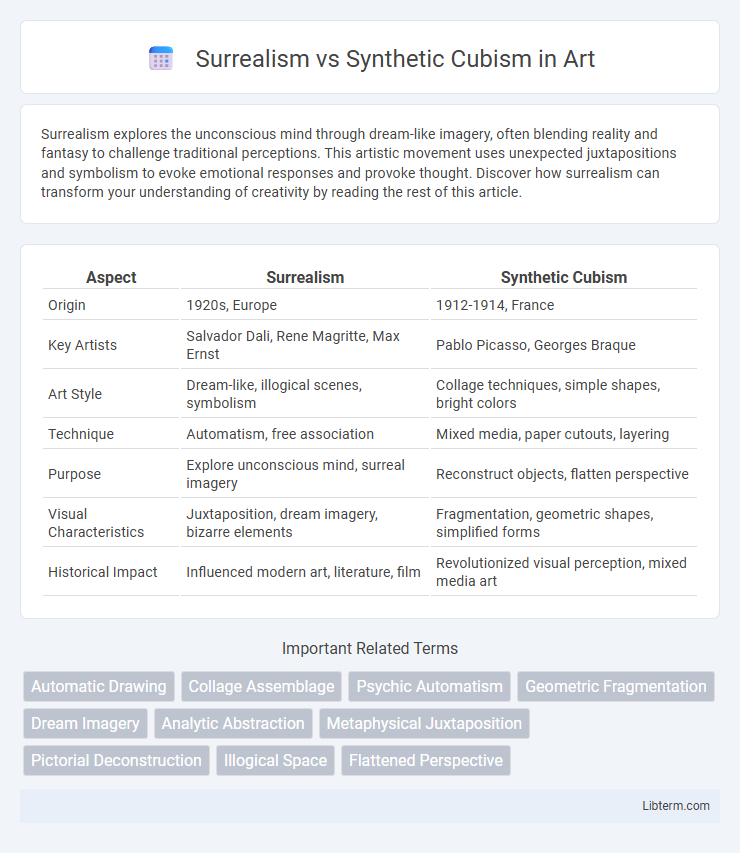Surrealism explores the unconscious mind through dream-like imagery, often blending reality and fantasy to challenge traditional perceptions. This artistic movement uses unexpected juxtapositions and symbolism to evoke emotional responses and provoke thought. Discover how surrealism can transform your understanding of creativity by reading the rest of this article.
Table of Comparison
| Aspect | Surrealism | Synthetic Cubism |
|---|---|---|
| Origin | 1920s, Europe | 1912-1914, France |
| Key Artists | Salvador Dali, Rene Magritte, Max Ernst | Pablo Picasso, Georges Braque |
| Art Style | Dream-like, illogical scenes, symbolism | Collage techniques, simple shapes, bright colors |
| Technique | Automatism, free association | Mixed media, paper cutouts, layering |
| Purpose | Explore unconscious mind, surreal imagery | Reconstruct objects, flatten perspective |
| Visual Characteristics | Juxtaposition, dream imagery, bizarre elements | Fragmentation, geometric shapes, simplified forms |
| Historical Impact | Influenced modern art, literature, film | Revolutionized visual perception, mixed media art |
Introduction to Surrealism and Synthetic Cubism
Surrealism emerged in the early 1920s as an avant-garde movement emphasizing dream imagery, subconscious exploration, and irrational juxtapositions to challenge traditional artistic conventions. Synthetic Cubism, developed by Pablo Picasso and Georges Braque around 1912-1914, introduced collage elements, simpler shapes, and brighter colors to reconstruct objects in abstracted, fragmented forms. Both movements revolutionized visual expression by breaking away from realistic representation, but Surrealism delved into psychological depths while Synthetic Cubism focused on formal experimentation with form and perspective.
Historical Context of Both Art Movements
Surrealism emerged in the early 1920s, influenced by the aftermath of World War I and the rise of psychoanalysis, emphasizing the exploration of the unconscious mind and dream imagery. Synthetic Cubism developed earlier, around 1912-1914, as a response to Analytical Cubism, simplifying forms and incorporating mixed media during a period marked by rapid industrialization and modernity in Europe. Both movements reflect a departure from traditional representation, shaped by significant cultural and historical shifts in early 20th-century Europe.
Key Philosophical Foundations
Surrealism emphasizes the exploration of the unconscious mind, dreams, and irrational imagery to challenge conventional reality and unlock deeper psychological truths. Synthetic Cubism focuses on deconstructing and reassembling objects through geometric shapes and multiple perspectives, highlighting the materiality and construction of the artwork. Both movements reject traditional representation but diverge in their philosophical approach: Surrealism delves into psychological freedom, while Synthetic Cubism deconstructs visual perception and form.
Main Artists and Influential Figures
Surrealism's main artists include Salvador Dali, Rene Magritte, and Max Ernst, who emphasized dreamlike imagery and the unconscious mind in their works. Synthetic Cubism, pioneered by Pablo Picasso and Georges Braque, focused on combining fragmented forms into cohesive compositions using collage and mixed media. Both movements significantly influenced modern art by challenging traditional representation and exploring new visual languages.
Visual Characteristics and Techniques
Surrealism emphasizes dreamlike imagery, distorted forms, and unexpected juxtapositions to evoke the unconscious mind, often using techniques like automatism and decalcomania to create spontaneous, imaginative visuals. Synthetic Cubism, in contrast, features simplified shapes, bright colors, and collage elements, constructing images from fragmented geometric forms and mixed media to represent objects from multiple perspectives. Both movements challenge traditional representation but differ in their approach--Surrealism explores psychological depth while Synthetic Cubism focuses on structural abstraction and materiality.
Differences in Subject Matter and Symbolism
Surrealism explores the unconscious mind through dreamlike, often bizarre imagery that emphasizes psychological symbolism and unexpected juxtapositions. Synthetic Cubism, in contrast, focuses on deconstructing objects into geometric shapes and reassembling them with simplified forms and collage elements to highlight the materiality of subjects. While Surrealism delves into emotional and irrational symbolism, Synthetic Cubism emphasizes analytical observation and the fragmentation of reality.
Impact on Modern Art Evolution
Surrealism revolutionized modern art by introducing subconscious exploration and dreamlike imagery, profoundly influencing abstract expressionism and contemporary visual narratives. Synthetic Cubism shifted the art paradigm through fragmented perspectives and collage techniques, laying the groundwork for various avant-garde movements and multimedia art forms. Both movements challenged traditional representation, accelerating the evolution of modern art by expanding creative possibilities and conceptual approaches.
Reception by Critics and Public
Surrealism received mixed reviews from critics, praised for its imaginative exploration of the unconscious mind but sometimes criticized for perceived obscurity and irrationality; the public was fascinated by its dreamlike, bizarre imagery that challenged conventional artistic norms. Synthetic Cubism, initially met with skepticism, gained appreciation for its fragmented forms and innovative collage techniques that redefined representation in art, appealing more to avant-garde critics and artists than the general public at first. Over time, both movements significantly influenced modern art, with Surrealism capturing popular imagination and Synthetic Cubism shaping future abstract styles.
Lasting Legacy in Contemporary Art
Surrealism's lasting legacy in contemporary art is seen in its influence on dreamlike aesthetics, psychological exploration, and the unconscious mind, shaping movements such as abstract expressionism and installation art. Synthetic Cubism's legacy resides in its fragmented forms, collage techniques, and multi-perspective approaches, which continue to inspire modern graphic design, digital art, and conceptual practices. Both movements pioneered innovative visual languages that disrupted traditional representation, deeply impacting contemporary artistic expression and narrative strategies.
Conclusion: Contrasts and Intersections
Surrealism emphasizes dreamlike, irrational imagery rooted in the subconscious mind, while Synthetic Cubism deconstructs objects into geometric forms and reassembles them in abstract compositions. Both movements challenge traditional representation, yet Surrealism explores psychological depth whereas Synthetic Cubism focuses on structural analysis and multiple perspectives. Their intersections lie in experimental techniques and a shared intent to expand visual language beyond conventional boundaries.
Surrealism Infographic

 libterm.com
libterm.com